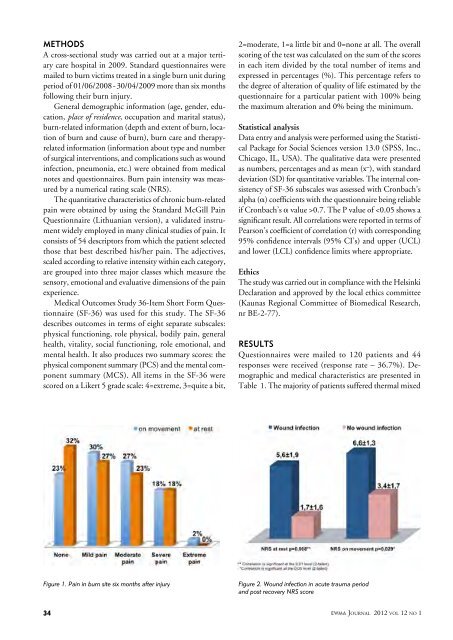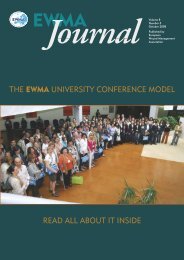FOCUS ON THE AUSTRIAN W UND ASSOCIATION - EWMA
FOCUS ON THE AUSTRIAN W UND ASSOCIATION - EWMA
FOCUS ON THE AUSTRIAN W UND ASSOCIATION - EWMA
- TAGS
- focus
- austrian
- association
- ewma
- ewma.org
Create successful ePaper yourself
Turn your PDF publications into a flip-book with our unique Google optimized e-Paper software.
METHODS<br />
A cross-sectional study was carried out at a major tertiary<br />
care hospital in 2009. Standard questionnaires were<br />
mailed to burn victims treated in a single burn unit during<br />
period of 01/06/2008 - 30/04/2009 more than six months<br />
following their burn injury.<br />
General demographic information (age, gender, education,<br />
place of residence, occupation and marital status),<br />
burn-related information (depth and extent of burn, location<br />
of burn and cause of burn), burn care and therapyrelated<br />
information (information about type and number<br />
of surgical interventions, and complications such as wound<br />
infection, pneumonia, etc.) were obtained from medical<br />
notes and questionnaires. Burn pain intensity was measured<br />
by a numerical rating scale (NRS).<br />
The quantitative characteristics of chronic burn-related<br />
pain were obtained by using the Standard McGill Pain<br />
Questionnaire (Lithuanian version), a validated instrument<br />
widely employed in many clinical studies of pain. It<br />
consists of 54 descriptors from which the patient selected<br />
those that best described his/her pain. The adjectives,<br />
scaled according to relative intensity within each category,<br />
are grouped into three major classes which measure the<br />
sensory, emotional and evaluative dimensions of the pain<br />
experience.<br />
Medical Outcomes Study 36-Item Short Form Questionnaire<br />
(SF-36) was used for this study. The SF-36<br />
describes outcomes in terms of eight separate subscales:<br />
physical functioning, role physical, bodily pain, general<br />
health, vitality, social functioning, role emotional, and<br />
mental health. It also produces two summary scores: the<br />
physical component summary (PCS) and the mental component<br />
summary (MCS). All items in the SF-36 were<br />
scored on a Likert 5 grade scale: 4=extreme, 3=quite a bit,<br />
2=moderate, 1=a little bit and 0=none at all. The overall<br />
scoring of the test was calculated on the sum of the scores<br />
in each item divided by the total number of items and<br />
expressed in percentages (%). This percentage refers to<br />
the degree of alteration of quality of life estimated by the<br />
questionnaire for a particular patient with 100% being<br />
the maximum alteration and 0% being the minimum.<br />
Statistical analysis<br />
Data entry and analysis were performed using the Statistical<br />
Package for Social Sciences version 13.0 (SPSS, Inc.,<br />
Chicago, IL, USA). The qualitative data were presented<br />
as numbers, percentages and as mean (x – ), with standard<br />
deviation (SD) for quantitative variables. The internal consistency<br />
of SF-36 subscales was assessed with Cronbach’s<br />
alpha (a) coefficients with the questionnaire being reliable<br />
if Cronbach’s a value >0.7. The P value of
















